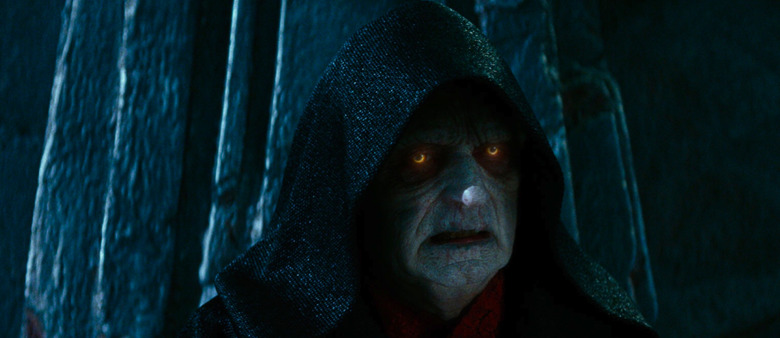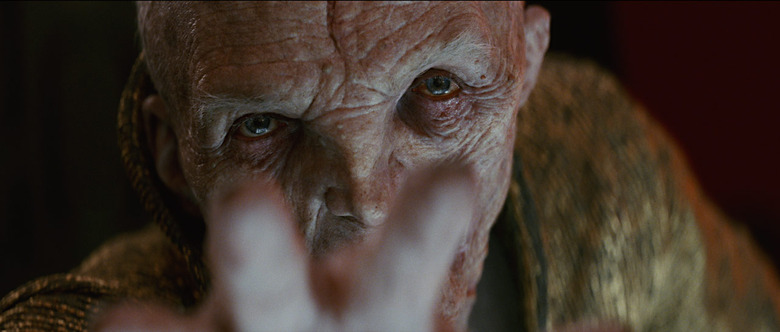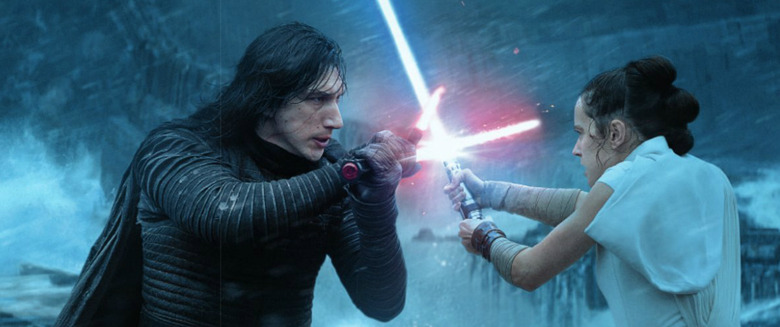Palpatine, Kylo Ren, Baby Yoda And More: 10 Things You Need To Know From 'The Star Wars Book'
A wise man once said: "If one is to understand the great mystery, one must study all its aspects, not just the dogmatic, narrow view of the Jedi." If you want to fully understand the epic and intricate Star Wars saga, you must embrace a larger view of the Force and you can start by embracing DK's new sacred text, The Star Wars Book: Expand Your Knowledge of a Galaxy Far, Far Away.
Written by Star Wars experts Pablo Hidalgo, Cole Horton, and Dan Zehr, this insightful examination of the ever-expanding Star Wars franchise covers 11 live-action movies, four TV shows comprising 15 seasons (and counting), video games, comics, novels, theme park experiences, and more.
Stuffed with illuminating infographics and authoritative essays, The Star Wars Book reveals the mysteries of the Star Wars galaxy — not just the characters, history, and technology of Star Wars, but how it all connects together, from 4-LOM and A-Wings to Ziro the Hutt and Zuckuss. While not technically an encyclopedia or visual dictionary, the book is divided into key subject areas for easy reading— the galaxy, science and technology, the Force, the Skywalkers, galactic governments, their dissidents, and galactic denizens.
Whether you are a devoted Star Wars fan or a casual reader curious to learn more, The Star Wars Book is an invaluable roadmap to that galaxy far, far away. Below is a sampling of some of the tome's most interesting tidbits, including new information on the events of The Rise of Skywalker and The Mandalorian.
The Pathway to Immortality
In Revenge of the Sith, Supreme Chancellor Palpatine, AKA Darth Sidious, tells us about The Tragedy of Darth Plagueis the wise, a Dark Lord of the Sith so powerful and so wise he could use the Force to influence the midi-chlorians to create life. The Star Wars Book provides a few more details about the Sith's quest for immortality:
Sidious' master, Darth Plagueis, thought the pathway to immortality lay in the sciences. He could coax midi-chlorians — the microscopic symbionts present in all body cells that channel the Force — to create new life. His experiments were incomplete but encouraging.
Like his former master, Sidious covets vergences in the Force, for such concentrations of power are needed to break the rules that govern life and death. This, of course, explains Sidious' fascination with young Anakin Skywalker, as well as the Force nexus on Lothal — the gateway beneath the ancient Jedi temple to the World Between Worlds, as seen in Star Wars Rebels:
Obsessed with immortality, Palpatine withdraws from public view so he can probe the secrets of the dark side. In the Unknown Regions, he readies the ancient Sith throne of Exegol to be his permanent seat of power. His cultist underlings experiment with cloning technology to extend his life.
Dark Science, Cloning, Secrets Only the Sith Knew
The Rise of Skywalker wasn't the first time Emperor Palpatine was resurrected. In the 1991 Dark Horse comic book series Dark Empire set six years after Return of the Jedi, Palpatine returns from the netherworld of the Force and possesses the body of Jeng Droga, one of the Emperor's Hands, a group of elite assassins not unlike the Knights of Ren or Snoke's Praetorian Guard in the Sequel Trilogy. Sate Pestage, one of the Emperor's advisors, exorcizes Palpatine's spirit and channels it into a clone created by Palpatine before his death.
As for how Palpatine returned in canon for Episode IX, The Star Wars Book lays it all out:
When Sidious is defeated at the Battle of Endor, he transfers his consciousness through the Force to a waiting cloned body. The process is imperfect, resulting in his mind being trapped in a rotting corpse. Over the ensuing decades, Sidious continues his obsessive explorations into rejuvenation. Clone offshoots from this process include his "son," who flees Exegol in an attempt to live a life apart from darkness. Another genetic construct becomes Snoke, an underling whom Sidious installs as Supreme Leader of the First Order.
Strandcast — Supreme Leader Snoke
If you've read my Emperor Reborn series or perused the Star Wars: The Last Jedi: The Visual Dictionary, you already know that Snoke, while not a member of the Sith, wore a gold ring inscribed with glyphs from the Four Sages of Dwartii, encrusted with obsidian from the Sith cave beneath Fortress Vader on Mustafar. Uncoincidentally, Supreme Chancellor Palpatine kept bronzium statues of the Four Sages in his office and chambers on Coruscant.
After The Rise of Skywalker, many fans had questions about who or what Snoke was. The Star Wars Book has the answer:
It's possible Snoke himself may not know his true nature. Snoke is a strandcast – an artificial genetic construct concocted by the resurrected Darth Sidious to be his proxy in power. Snoke has free will, but his actions and goals are still orchestrated by Sidious.
Through Snoke, Sidious manipulates Anakin Skywalker's grandson, Ben Solo, and lures him to the dark side. Sidious also senses the Force awakening within Rey, the offspring of his cloned son, and is determined to capture her.
Psychometry, Dyads, and Rare Force Abilities
The book also details some rarer force abilities. A small number of Force users, including Rey and Cal Kestis (from the video game Star Wars Jedi: Fallen Order), have the unique ability of psychometry, which allows them to learn about people or events by touching an object associated with them. This explains Rey's Force visions when she touches items like Anakin Skywalker's lightsaber or the Blade of Ochi of Bestoon.
As for Rey's bond with Ben Solo, here's the official info:
Ben Solo and Rey are dyads in the Force. This rare connection has not been seen for generations and means that the pair have a Force bond, allowing them to see and feel what the other is experiencing and even pass objects to one another over great distances through the Force. Those in a dyad possess another unusual ability. They can use the Force to heal a wounded person or creature, but this act also requires that the healer transfer some of their Force energy, which can temporarily weaken them. After their battle with Darth Sidious, Ben Solo sacrifices his life and all of his Force energy to bring Rey back from the dead.
Eternal Hope and Redemption — Ben Solo and Leia Organa
What happened to Ben Solo and Leia Organa at the end of The Rise of Skywalker? The book provides some additional details about their final moments.
Amid the wreckage of the second Death Star on Kef Bir, Kylo Ren feels the Force presence of his mother, who reminds him of the goodness still within him. Sensing his distraction, Rey strikes a killing blow with her lightsaber. Immediately horrified by her actions and the idea that she may be falling to the dark side, Rey uses the Force to restore him. Meanwhile, on Ajan Kloss, the effort of reaching out to her son is too much for Leia's mortal body. She dies but doesn't pass into the Force yet:
In a pivotal turn of events, Kylo faces the memory of his deceased father. Moved by the love of his parents and Rey's compassion, he hurls his unstable, red lightsaber into the ocean, renouncing darkness and becoming Ben Solo once more. His final act is to head to Exegol to help Rey face the Emperor. Together, the two defeat the Sith Lord. The effort drains Rey. Without hesitation, Ben transfers his life force to her, resurrecting her and sacrificing himself: redeemed at last.
By transferring all of his Force energy to resurrect Rey, Ben Solo is able to do what his grandfather Anakin Skywalker never could: save the ones he loves from dying. Now one with the force, Leia ferries Ben into the cosmic Force together, finding peace.
Finding Her Identity — The Mirror Cave and Rey Skywalker
For those who have issues or questions about Rey's arc in the Sequel Trilogy, The Star Wars Book does a good job of explaining everything and connecting the thematic dots. For one, we get a full understanding of Rey's experience in the mirror cave on Ahch-To in Rian Johnson's The Last Jedi:
Below the surface, she asks the Force to show her who her parents are. In answer, the cave reveals not a mother or a father but Rey's mirrored image, endlessly reflected. The cave plays upon her darkest fears, that she has always been, and always will be, alone. But it also helps her begin to see that maybe the only person she needs is herself. She is not defined by her parents, but by the choices she makes.
And so, determined to forge her own identity, Rey goes to Exegol and battles Palpatine, nearly dying in the process:
Having accepted all that she is, the voices of many legendary Jedi unite with her, inspiring her to rise and destroy Palpatine with the help of Ben Solo, now returned to the light. On Tatooine, Rey buries Luke and Leia's lightsabers and takes on the moniker Skywalker. Her choice, and not her lineage, defines who she is, bringing her peace and purpose.
Hero Business — Lando Calrissian
There are some fun tidbits about supporting characters to the saga as well, specifically this interesting backstory for Lando Calrissian that was cut from The Rise of Skywalker but still exists as part of the official novelization:
After his days in the Rebellion, Calrissian settles down and starts a family. However, his young daughter is kidnapped. Her disappearance is a mystery, yet it becomes clear later that his only child was targeted by the First Order, as the group had abducted the kids of other former Alliance leaders. Lando joins Luke Skywalker's mission to track down the rumors of Sith agents, and when the trail runs cold on Pasaana, Lando decides to remain on the planet, living a quiet, restful existence as a hermit.
With the battle against the Final Order won, Lando offers to join the former stormtrooper Jannah in her search for her family, hoping that together they can find their long-lost relatives, even if the odds are against them:
He empathizes with her as his own child had been kidnapped years before. Jannah, an improbable ally to the Resistance, has found an unlikely ally of her own.
The Mandalorian — Din Djarin
In the Mandalorian's entry, we learn that before he was rescued by members of Death Watch, Din Djarin called Aq Vetina his home:
Although now known as the Mandalorian, he was once the boy named Din Djarin. When his home, Aq Vetina, is assulated by merciless battle droids forces, Din's parents hide him in a cellar, hoping to keep him safe. He survives, thanks to the intervention of Mandalorian forces. Armored warriors carrying the mark of Death Watch take the abandoned child to be raised as a Mandalorian foundling. Din receives an orthodox Mandalorian upbringing so he believes he cannot ever take his helmet off in the company of another living being, lest he lose claim to his Mandalorian heritage.
Is Aq Vetina the name of a settlement, or is it a planet? Perhaps we'll visit the Mandalorian's former home in an upcoming episode of the Disney+ live-action series.
The Child — A Nobody From Nowhere (For Now)
As for Din Djarin's sidekick, the Child, there isn't much new information to report:
Very little is known about the Child, the Mandalorian's target-turned-ward. He is found sleeping in a hovering pram in a safehouse on Arvala-7, guarded by Nikto henchmen. Where he came from is unknown. According to a fragmented chain code, the Child is 50 standard years old, but has the look and behavior of a toddler. His species is unknown, but is a match for that of Yoda, the late Jedi master.
While there have been several members of the species to make appearances in the non-canon Expanded Universe (rebranded as Star Wars Legends), there are only three in the official Star Wars canon: Yoda, Yaddle, and the Child. Someday, maybe someday soon, we'll discover more about the species and where they come from but until then, much to learn we still have.
The New Gospel
While there are countless Star Wars reference books out there, The Star Wars Book feels like something new and different. It isn't a visual dictionary, nor is it an art book. It's more like a hardbound copy of Wookieepedia that exhaustively details the major players and events of the saga and binds the universe together. That was a book joke and a Star Wars joke. You're welcome.
The Star Wars Book fills in the gaps for those who don't have the time, money, or obsessive-compulsive need to consume everything that comes out of Lucasfilm and its subsidiaries, while also encouraging those who are curious to seek out stories and experiences they may have missed along the way. It treats the films, series, comics, novels, and video games as equally important parts of the Star Wars canon and is a must-have for fans of saga.
***
The Star Wars Book is available now.




